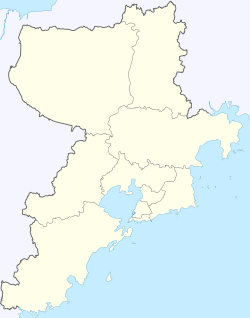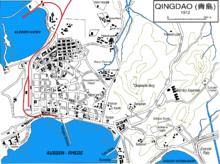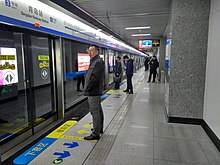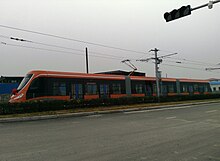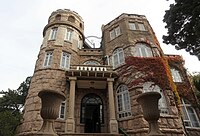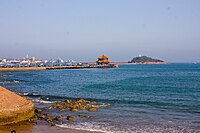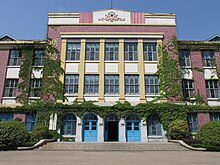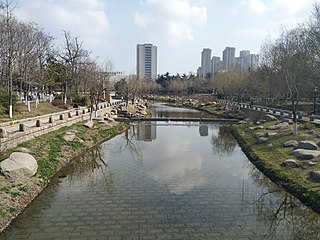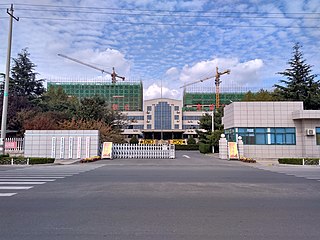Qingdao 青岛市 Tsingtao | |
|---|---|
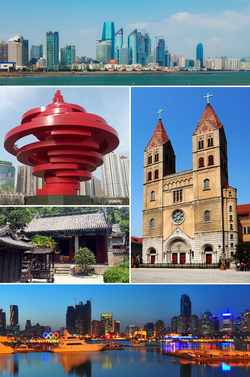 Clockwise from top left: Qingdao's skyline, St. Michael's Cathedral, Qingdao harbor, a temple at the base of Mount Lao, and May Fourth Square | |
 | |
 Location of Qingdao City jurisdiction in Shandong | |
| Coordinates(Qingdao municipal government): 36°04′01″N120°22′58″E / 36.0669°N 120.3827°E | |
| Country | China |
| Province | Shandong |
| Lease to Germany | 6 March 1898 |
| Japanese occupation | 7 November 1914 |
| Return to China | 10 December 1922 |
| Japanese Occupation | 10 January 1938 |
| Return to China | 15 August 1945 |
| Municipal seat | 11, Xianggang Middle Rd, Shinan District |
| Government | |
| • Type | Sub-provincial city |
| • Body | Qingdao Municipal People's Congress |
| • CCP Secretary | Lu Zhiyuan |
| • Congress Chairman | Wang Luming |
| • Mayor | Zhao Haozhi |
| • CPPCC Chairman | Yang Jun |
| Area | |
| • Prefecture-level and Sub-provincial city | 11,228.4 km2 (4,335.3 sq mi) |
| • Land | 11,228.4 km2 (4,335.3 sq mi) |
| • Urban | 5,171.4 km2 (1,996.7 sq mi) |
| • Metro | 5,171.4 km2 (1,996.7 sq mi) |
| Population (2020 census) [1] | |
| • Prefecture-level and Sub-provincial city | 10,071,722 |
| • Density | 900/km2 (2,300/sq mi) |
| • Urban | 7,172,451 |
| • Urban density | 1,400/km2 (3,600/sq mi) |
| • Metro | 7,172,451 |
| • Metro density | 1,400/km2 (3,600/sq mi) |
| GDP [2] | |
| • Prefecture-level and Sub-provincial city | CN¥ 1.200 trillion US$ 181.4 billion |
| • Per capita | CN¥ 128,459 US$ 19,412 |
| Time zone | UTC+8 (China Standard) |
| Postal code | 266000 |
| Area code | 0532 |
| ISO 3166 code | CN-SD-02 |
| License Plate Prefix | 鲁B & 鲁U |
| Coastline |
|
| Major Nationalities | Han: 99.86% |
| County-level divisions | 10 |
| Climate | Dwa/Cwa |
| Website | qingdao.gov.cn |
| Symbols | |
| Flower | China rose Camellia |
| Tree | Cedrus |
| Qingdao | |||||||||||||||||||||||||||||||||||
|---|---|---|---|---|---|---|---|---|---|---|---|---|---|---|---|---|---|---|---|---|---|---|---|---|---|---|---|---|---|---|---|---|---|---|---|
 "Qingdao" in Simplified (top) and Traditional (bottom) Chinese characters | |||||||||||||||||||||||||||||||||||
| Chinese name | |||||||||||||||||||||||||||||||||||
| Simplified Chinese | 青岛 | ||||||||||||||||||||||||||||||||||
| Traditional Chinese | 青島 | ||||||||||||||||||||||||||||||||||
| Postal | Tsingtao | ||||||||||||||||||||||||||||||||||
| Literal meaning | "Qing (color) Island" | ||||||||||||||||||||||||||||||||||
| |||||||||||||||||||||||||||||||||||
| German name | |||||||||||||||||||||||||||||||||||
| German | Tsingtao | ||||||||||||||||||||||||||||||||||
Qingdao [lower-alpha 1] is a city in eastern Shandong Province of China. Located on China's Yellow Sea coast,it is a major nodal city of the Belt and Road Initiative (BRI) that connects Continental and East Asia with Europe. [3] It has the highest GDP of any city in the province. Administered at the sub-provincial level, [4] Qingdao has jurisdiction over seven districts and three county-level cities (Jiaozhou,Pingdu,Laixi). As of the 2020 census,Qingdao built-up (or metro) area made of the seven urban districts (Shinan,Shibei,Huangdao,Laoshan,Licang,Chengyang and Jimo) was home to 7,172,451 inhabitants,making it the 15th largest city in China by population. [5] Lying across the Shandong Peninsula and looking out to the Yellow Sea,it borders the prefecture-level cities of Yantai to the northeast,Weifang [6] to the west and Rizhao to the southwest. [7]
Contents
- History
- Antiquity
- German and Japanese occupations
- Qingdao city planning and development
- Postwar
- Administrative divisions
- Geography
- Climate
- Demographics
- Economy
- Industrial zones
- Transport
- Road
- Marine
- Aviation
- Intercity rail
- Public transport
- Culture
- Architecture
- Notable people
- Movies shot in Qingdao
- Language
- Festivals
- Media
- Tourism
- Western Shinan district
- Eastern Shinan district
- Laoshan district
- Education
- Higher education
- International schools
- Secondary schools
- Sports
- Stadiums
- 2008 Olympic Summer Games
- Motorsport
- Sister cities
- See also
- Notes
- References
- Citations
- Sources
- External links
Qingdao is a major seaport and naval base,as well as a commercial and financial center. It is home to electronics multinationals such as Haier and Hisense. The Jiaozhou Bay Bridge,links the main urban area of Qingdao with Huangdao district,straddling the Jiaozhou Bay sea areas. Its historic German-style architecture and Tsingtao Brewery,the second largest brewery in China, [8] are legacies of the German occupation (1898–1914). Qingdao is classified as a Large-Port Metropolis. [9]
In the 2020 Global Financial Centers Index,Qingdao ranked 47th;the index is published by the Z/Yen Group and China Development Institute,the other Chinese cities on the list being Shanghai,Hong Kong,Beijing,Shenzhen,Guangzhou,Chengdu,Nanjing,Xi'an,Tianjin,Hangzhou,Dalian,and Wuhan. [10] In 2007,Qingdao was named as one of China's top ten cities by the Chinese Cities Brand Value Report,which was released at the 2007 Beijing Summit of China Cities Forum. [11] In 2009,Qingdao was named China's most livable city by the Chinese Institute of City Competitiveness. [12] [13] In 2018,Qingdao held the Shanghai Cooperation Organisation summit. [14] In 2020,Qingdao was rated as a Gamma+ level global city by the Globalization and World Cities Research Network. [15]
Qingdao is also one of the world's top 50 cities for global scientific research as tracked by the Nature Index. [16] The city is home to several notable universities,including the Ocean University of China,China University of Petroleum,Shandong University of Science and Technology,Qingdao,Qingdao University of Science and Technology Qingdao University of Technology,and Qingdao Agricultural University. [17]

